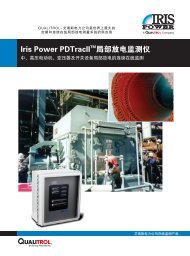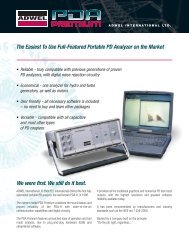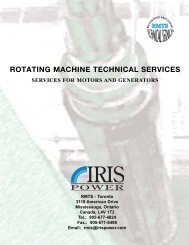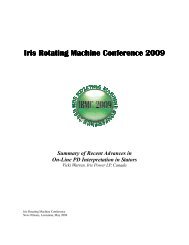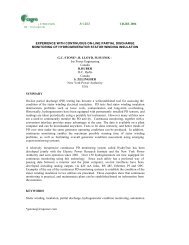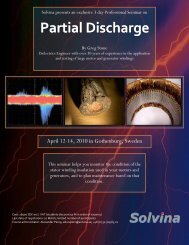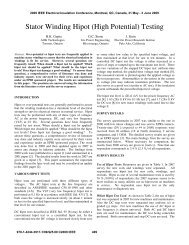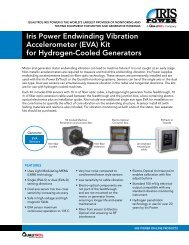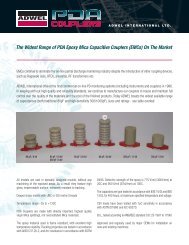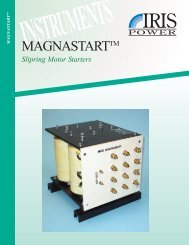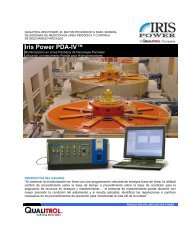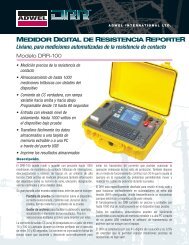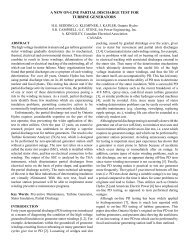Partial Discharge Diagnostics and Electrical Equipment Insulation ...
Partial Discharge Diagnostics and Electrical Equipment Insulation ...
Partial Discharge Diagnostics and Electrical Equipment Insulation ...
You also want an ePaper? Increase the reach of your titles
YUMPU automatically turns print PDFs into web optimized ePapers that Google loves.
Beginning in the early 1970’s, Kelen introduced aprimitive form of what is now called a pulse phaseanalyzer (PPA) also known as a phase-resolved pulsemagnitude analyzer [8]. The PPA is similar to thePMA, with the exception that the phase angle of theAC cycle is also digitally recorded for each PD pulse.The result is a digital representation of the informationthat was originally measured over a complete ACcycle on an oscilloscope. The output of the PPA is atwo or three-dimensional plot of the pulse count ratevs. the pulse magnitude vs. the AC phase position ofthe pulses. There are many ways to display thisoutput. Fruth [13] <strong>and</strong> Fujimoto [14] popularized atwo-dimensional colorized presentation of the PPAdata (Figure 3). Usually the pulse repetition rate isdisplayed via a color code – which unfortunately is notst<strong>and</strong>ardized. Virtually all commercial PDinstrumentation made in the past 10 years produces thePPA plots.Pulse Magnitude [mV]3020100-10-20-30Bipolar Slot Total0 to 3.16 pps 3.16 to 10 pps 10 to 31.6 pps 31.6 to 100 pps100 to 316 pps 316 to 1000 pps > 1000 pps Subset 80 45 90 135 180 225 270 315 360Phase Angle [deg]Figure 3: Pulse phase analysis (PPA) plot of the pulsemagnitude versus AC phase position, with the pulse countrate in pulses per second represented as color.The widespread use of digital instrumentation, whichproduces the PMA <strong>and</strong> PPA plots has reduced the needfor human experts to be present at the PD test. Withthe older analog technology, the expert’s presenceduring the test was needed so the expert coulddetermine peak PD magnitudes from the flickeringtraces <strong>and</strong> determine if noise was present during themeasurement. With digital instrumentation, <strong>and</strong> thepermanent recording that it enabled, the expert couldreview the data transmitted by email to a lab or office.3020100-10-20-30This facilitated a considerable productivityimprovement for PD test experts, which in turnlowered test costs.Most of the commercial PD instrumentation in usetoday uses an analog-to-digital converter withsampling rates of about 20 MHz, corresponding to amaximum analog b<strong>and</strong>width of about 10 MHz. Theseare completely compatible with IEC 60270 narrowb<strong>and</strong> <strong>and</strong> wide b<strong>and</strong> detectors. However, somesuppliers are using digitizers with b<strong>and</strong>widths up to350 MHz to enable ultra wideb<strong>and</strong> PD detection, withthe consequent advantages of noise separation <strong>and</strong> PDsite location [4,14,15].2.3.2 NOISE SEPARATIONAs condition assessment has become an importantaspect of PD testing, the desire of users to do on-site<strong>and</strong> on-line PD testing has increased. Off-line testingrequires a shutdown of the HV equipment, <strong>and</strong> oftenalso requires a substantial HV test transformer toenergize the capacitance of the test object. In contrast,on-line tests are done during normal operation of theHV equipment where the apparatus is exposed torealistic operational stresses, so no shutdown isrequired; <strong>and</strong> an HV test transformer is not required.Unfortunately, there is usually much more electricalinterference to contend with in on-site <strong>and</strong> on-linetesting, since the test object is connected or near to thepower system. <strong>Electrical</strong> interference can come fromcorona on air-insulated transmission <strong>and</strong> distributionlines, power tool operation, arc welding, poorelectrical contacts, electrostatic precipitators, etc., allof which produce sparks/discharges that create currentpulses similar to PD. Separating this noise from testobject PD is important since if the noise is mistaken asPD, a false indication of the insulation deterioration isgiven, reducing the usefulness <strong>and</strong> the credibility ofthe PD test.Experts reviewing the PD patterns in PPA plots canusually separate noise from PD – although theseparation is subjective. Automated patternrecognition (see Section 2.4) may also separate PDfrom noise. However, in the past 20 years somehardware (sensors <strong>and</strong> instrumentation) methods toseparate PD <strong>and</strong> noise have also been implemented toseparate PD from noise.



